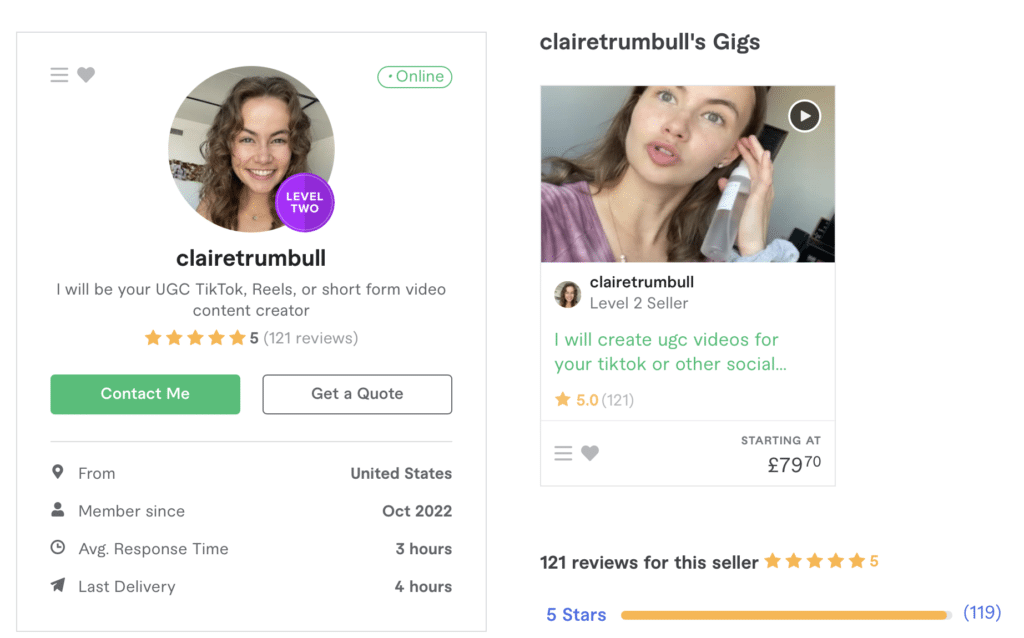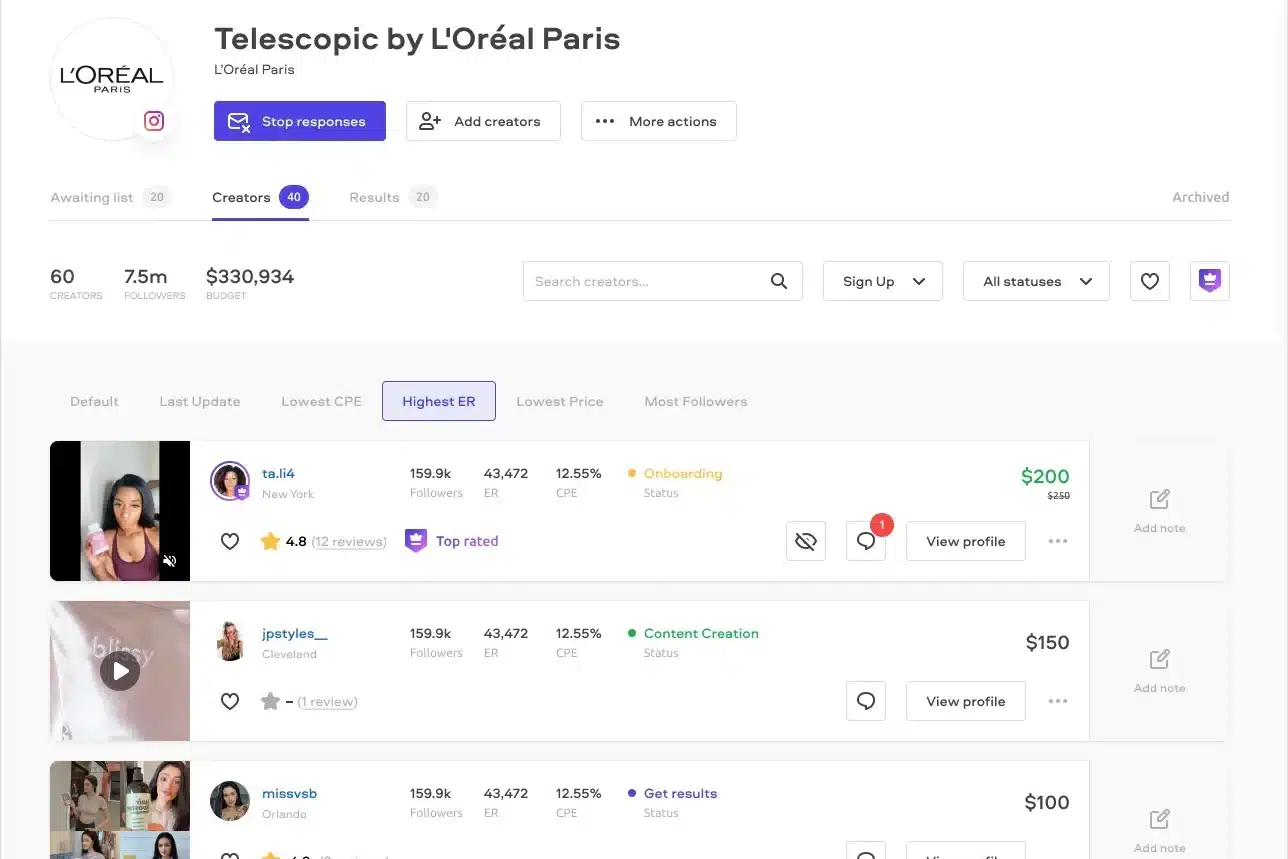
As a content creator, it can often feel like you’re up against it when it comes to landing UGC jobs. The good one’s at least.
It’s a competitive landscape out there, but there’s plenty of work to go around – if you know where to find UGC jobs. With the right strategies and platforms, paid UGC opportunities await.
In our guide, we’re outlining the top places for UGC content creators can find work.
From leveraging social media platforms to up and coming UGC platforms and agencies, we’ll cover various avenues to help you secure that bag and get on your way to earning $$$$.
Social Media Platforms
Let’s face it, UGC and social go hand and hand. It’s hardly surprising thats social media platforms offer immense potential for UGC content creators to find work. Sure, optimizing your own profiles can work wonders for attracting inbound leads, but they can also be a goldmine for finding companies to target directly.
Knowing where to find UGC clients on Facebook can be the secret to unlocking brands with significantly higher budgets than what you would find elsewhere. You can get paid more for creating a paid ad for a brand than you can by creating a video for organic purposes. Why? Because nine times out of ten that brand can make a lot more with that paid ad. Because of this, brands typically allocate more budget to paid media vs. organic content.
So, if you want to find brands with higher budgets, you’re going to want to find brands running paid ads. The best place for this is the Facebook Ads Library.
It’s completely free, and it shows you every single ad that is running on Facebook and Instagram.

LinkedIn has emerged as a powerful platform for content creators looking to connect with potential UGC clients.
Once you have a strong profile and content, it’s time to start connecting with decision makers.You can literally build a following of targeted decision makers that work at brands in your industry. Every month, you can connect with executives at companies within your niche – executives that have the hiring power.
Say sia-nara to refreshing the top UGC platforms and instead let the deals come to you by mastering Linkedin for UGC.
You’ve almost certainly given this one a go, and you’ve almost certainly sworn off ever doing it again. Twitter job postings are frequent, probably too frequent for my liking and can be fishy at times. ‘Agencies’ often post on behalf of brands actively seeking UGC creators using hashtags – #UGCcreator #UGCneeded #ugc #ugccreators #ugcopportunity.
Some are legit, most are not, and those that are tend to be very competitive. If I were you, I’d swerve the general posts and instead find some really reputable agency owners who often post call-outs, for example, Alex Cooper, the co-founder of AdCrate. Turn on notifications and be prepared to engage with his content, truth be told, you’ll gain a lot more from doing that then applying to every single post going on the hashtags.
✅ Pros: This approach enables direct contact with brands, potentially providing significant exposure.
❌ Cons: Competition is fierce, and it can be challenging to stand out among other UGC creators vying for the same opportunities.
Freelancer Platforms
In the ever-evolving landscape of UGC creation, freelancer platforms have emerged as valuable hubs for creators to get their first few jobs. Platforms such as Fiverr and Upwork essentially connect creators with clients seeking their services. Jobs vary in quality, and tend to offer pittance as payment, but there are certainly some great clients to be found if you kiss enough frogs.
Fiverr
Fiverr has gained popularity as a go-to platform for freelancers across various creative fields, and UGC is no exception. With Fiverr, you’ll create a professional profile and offer specialized UGC services that a client can then hire you for. It offers a diverse marketplace for you to showcase your talent, but also requires a lot of grit to stick with it for long enough to get enough positive reviews to make it up the rankings.

Upwork
Upwork is another leading freelancer platformIt connects clients with freelancers from around the world, but unlike Fiverr, it offers you the opportunity to apply to jobs. You can add packages to your profile, but ultimately, it puts the onus on you to apply to clients jobs. This does mean that fees can also be pitiful, but I’ve managed to secure some long-term collaborations with reputable brands through the platform, so don’t rule it out just yet.
Navigating Freelancer Platforms: Tips for Success
While freelancer platforms can be a goldmine for UGC creators, standing out among the competition requires strategic efforts. Here are some tips to maximize your success:
- Craft a compelling profile: Create a professional and engaging profile that highlights your UGC skills, experience, and past projects. Use SEO driven, attention-grabbing descriptions and showcase your unique value proposition. Curate your best UGC work to showcase your capabilities and attract potential clients.
- Set competitive rates: Set competitive rates that reflect your skill level and experience, but that are realistic to the platform. Be open to negotiation but ensure your rates align with the value you provide.
- Communicate effectively: Communication is key, and go over and above to understand client needs and deliver high-quality work within the agreed-upon timeframe. Aim for excellent client satisfaction and encourage clients to provide feedback and reviews on the platform.
✅ Pros: Advantages: These platforms simplify the process of finding work, and you may secure long-term partnerships.
❌ Cons: Competition for jobs can be fierce, and establishing a reputation may be necessary before securing consistent work.

Brands Meet Creators
Brand Meets Creators is a no bells and whistles email list. And yet, it’s without a doubt one of my favourites. Brand Meets Creators is a weekly email newsletter that sends brand deals sent directly to your inbox. You’ll then apply for them using a Jotform and bob’s your uncle, wait for the brand to choose you.
Not to sugar coat it, it can be competitive as hell, but you’re talking 15-20 potential deals that land in your inbox at 8am on a Thursday morning.
Get there first, and you never know. You’re not going to find ‘SONY’ or ‘Loreal’ hanging out in the newsletter, but you are going to find some great startups and D2C brands which arguably have better budget’s available for UGC style content.
✅ Pros: No barrier to entry, jobs come to you
❌ Cons: No big brands, can be competitive
UGC Platforms
UGC platforms are online platforms or marketplaces dedicated to connecting UGC creators with brands. These platforms provide a space where brands can discover UGC creators, review their work, and engage in collaborations.
UGC creators can create profiles, showcase their content, and connect with potential clients through these platforms. Most platforms then handle payment and provide additional resources for creators. It’s a mixed bag, with some better than others, but these are worth signing up to and checking as part of your daily routine.
Some of the top UGC platforms include:
- hashtagPaid
#paid shies away from traditional models of influencer marketing. Or so it says. It was one of the first platforms to target campaigns for different sections of the sales funnel. Brands can use #paid to create campaign briefs describing campaign goals, the scope of desired content, and a little about the ideal creator. To apply for a brand campaign, you’ll “raise” their hand to indicate interest. You’ll then write a message describing why you’re a good fit for a job, and what your approach would be.
- Insense
Insense is an app — don’t worry, it’s reputable — that is partnered with all of the big social media players. In their own words: ‘Insense is an industry game changer. Just imagine a place where brands meet creators and they come together to product awesome content for the world.’ Once in, you’ll be able to apply to various jobs on the explore page.
You can apply for jobs in UGC, UGC + Paid Posting and Influencer Whitelisting.

- Collabstr
Collabstr is a great place to start when you want to dip your toe in the water of paid collaborations. It’s a self-serve platform — you are free to manage your own deals. Think of it as Tinder, but for UGC creators jobs. Brands can scroll, swipe and find the best options for them for an upcoming campaign. For me, Collabstr is a no brainer. It’s essentially another place to be visible to brands, and let them come to you.
✅ Pros: These platforms offer a streamlined approach to finding work, and you may find opportunities for lasting partnerships.
❌ Cons: Competition for jobs on these platforms can be intense, and it may take time to establish a strong presence and secure consistent work.
Agencies
Partnering with a UGC agency can expand your opportunities, provide valuable industry insights, and connect you with high-profile clients. Collaborating with an agency can elevate your career, opening doors to exciting UGC creator jobs, professional growth, and long-term success – if you choose the right one.
Research and choose reputable agencies that align with your creative goals and values.
UGC agencies have established connections with a wide range of clients, including brands, businesses, and media companies. By partnering with an agency, you gain access to their extensive network, increasing your chances of landing high-profile UGC creator jobs.
UGC agencies also possess in-depth knowledge and experience in the UGC space. They understand client expectations, market trends, and best practices for creating impactful UGC. Working with an agency allows you to tap into their expertise, benefiting from their guidance, feedback, and strategic direction. They can offer valuable insights on how to improve your work and navigate the UGC industry successfully.
✅ Pros: Agencies often have existing relationships with clients who regularly seek UGC services, providing a steady stream of opportunities.
❌ Cons: Agencies will take a cut of your earnings, and there are more frogs than princes when it comes to the world of UGC agencies – be very careful with who you choose to sign with.

Outbounds
Rather than reaching out to specific brands, consider approaching PR and marketing agencies with your UGC content pitch. This approach can be more effective, as agencies often collaborate with UGC creators on behalf of brands. To do so, you’ll need to have your UGC portfolio nailed down and have mastered the art of crafting a compelling pitch email.
This a crucial skill that can make all the difference in securing partnerships.
Before you even think about hitting send, consider your target audience.
Tailoring your approach based on the type of brands or agencies you are reaching out to can significantly enhance your pitch’s effectiveness.
Broadly speaking, there are three main categories you may be pitching to:
Small Brands
When targeting small brands, focus on highlighting the value and impact your UGC can bring to their marketing efforts. Emphasize how your content can help them establish a strong online presence, engage their audience, and drive conversions. Small brands often appreciate personal connections, so showcase your understanding of their unique challenges and objectives.
Big Brands
Pitching to big brands requires a different approach. They typically receive numerous partnership requests, so your pitch needs to stand out. Highlight your experience, track record, and any notable achievements to demonstrate your ability to deliver exceptional UGC. Big brands often prioritize collaborations that align with their values and resonate with their target audience, so tailor your pitch accordingly.
Agencies
When pitching to agencies, focus on the benefits of partnering with you as a UGC creator.
Showcase how your content can enhance their clients’ campaigns and provide a fresh, authentic perspective. Agencies are often looking for reliable and creative collaborators, so emphasize your professionalism, flexibility, and ability to meet deadlines.
✅ Pros: You have the freedom to approach any brand you desire without intermediary fees.
❌ Cons: Brands may not always respond to cold emails, and it may require sending numerous emails before receiving positive responses.
Inbounds: Build Your Own Profile
Inbound refers to cases where brands or companies approach UGC creators directly.
Brands may reach out to creators based on their social media presence, or reputation — almost always as a result of the creator’s visibility. Remember, building a strong profile is an ongoing process.
Continuously update your portfolio, adapt to changing trends, and stay active in your chosen UGC community. By building an impressive online presence, you’ll attract UGC clients who recognize your talent, value your skills, and are eager to collaborate with you on exciting projects.
Get That Bag!
As a creator, finding UGC creator jobs requires a strategic approach and knowledge of the right platforms to explore.
Whether you opt for social media platforms, UGC platforms and agencies, cold emailing, or Twitter casting calls, numerous opportunities exist for UGC content creators.
By leveraging these platforms and presenting your work effectively, you can start building your reputation and securing projects that align with your interests and skills.
Stay persistent, showcase your creativity, and watch your UGC career thrive.










